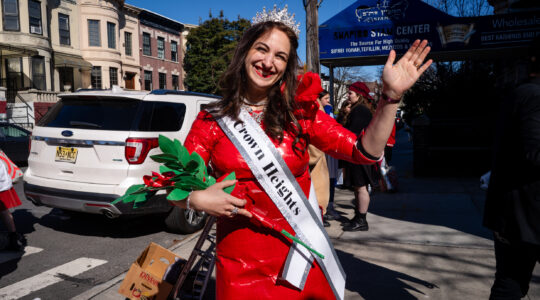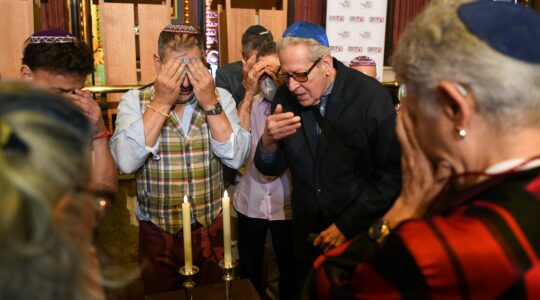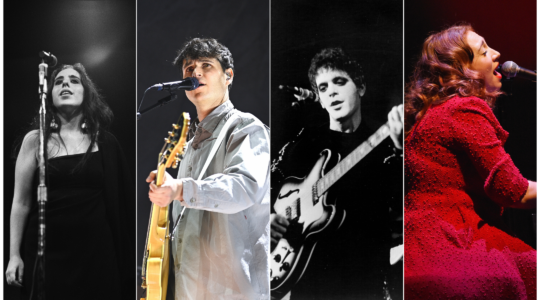The Museum of Jewish Heritage-A Living Memorial to the Holocaust is closing its doors: and opening a window, of sorts.
From mid-January through mid-March, the museum in Battery Park will close temporarily as part of a long-anticipated expansion. When the institution reopens on March 16, its distinctive hexagonal-shaped building will connect via a glass-walled walkway to an 82,000-square-foot addition. The expansion, which should be complete and open to the public next fall, triples the museum’s size and creates facilities for programs and exhibitions that until now have been practically non-existent.
A program on Christmas Day, for example, treated about 450 visitors to a performance by Metropolitan Klezmer in a 1,500-square-foot hall on the third floor, a room with stunning river views that also doubles as agallery for temporary exhibitions. On a recent Wednesday afternoon, that same gallery was the end point for a continuous flow of students, who gathered in clumps at the windows overlooking Ellis Island and the Statue of Liberty or wandered past display cases in an exhibit about 9-11.
"We don’t have an auditorium, any large exhibition hall, any place for changing exhibitions, any classrooms, any office space," the museum’s chairman, Robert Morgenthau told the Jewish Week. Morgenthau, who is district attorney for Manhattan, said the museum’s board deliberated over whether to go forward with the $60 million expansion following the terrorist attacks, but decided to stick to their plans.
"A big thing in this business is momentum," he said. "You’ve got to keep it going." Otherwise, he said, "people lose interest and think you’re dead."
Indeed, the business of Jewish museums is experiencing something of a boom these days. In Philadelphia, the National Museum of American Jewish History recently received $25 million toward its $100 million new building on Independence Mall. A Jewish museum is being planned in Cleveland, and the Skirball Museum in Los Angeles completed a major expansion last year.
At the same time, Jewish museums, like their secular counterparts, are feeling the pinch of a post-9-11 drop in attendance. "There’s a contradiction going on," said Laura Apelbaum, the chair of the Council of American Jewish Museums. Still, she said, "It’s phenomenal, the dollars and resources going toward Jewish institutions."
The Museum of Jewish Heritage is experiencing both contradictory trends. About half of its expansion costs are covered by state and city funds. Private support accounts for the rest, including $6 million from the Safra Foundation. Contributing trustees include MTA chairman Peter Kalikow, real estate developer Bernard Spitzer and Wall Street mogul Michael Steinhardt.
On the other hand, attendance is still recovering from 9-11’s derailment, according to museum officials. By Sept. 10, 2001, the museum had already beaten total attendance for 2002. Some 2,200 visitors had come in the first eight days of September 2001 alone. Totals for 2002, through November, were just short of 70,000.
Sitting only five blocks south of Ground Zero, the museum witnessed the 9-11 attacks up close, and for weeks Battery Park was "an armed camp," said David Marwell, the museum’s director of two years. The museum reopened on Sept. 20, but the first school group ó students from Banana Kelly High School in the Bronx ó did not arrive until the end of November. School groups account for between 30 and 40 percent of the museum’s audience.
The Museum also experienced personal tragedy. This spring, a construction foreman working on the expansion, Attilio Dellapina, died after being struck by foundation piling. He was 57.
"We’re coming off a very, very tough year," Marwell said. But he stressed that the museum’s expansion demonstrates the importance of rebuilding after a catastrophe. As an institution whose mission is to teach people of all ages and backgrounds about 20th-century Jewish history and the Holocaust, the expansion "is a wonderful and appropriate way for the museum to give positive expression to that conviction."
The museum has overcome obstacles throughout its history. It began as the brainchild of former Mayor Ed Koch, who created an initial commission in 1983. And while critics questioned the use of public funds for a Jewish museum, budget woes delayed a 1996 opening and curtailed the building of amenities that are part of the current extension. Plans for expansion were marred in 1999 by political wrangling between the mayor and governor.
For now, plans are progressing peacefully. "We’re on schedule, on budget and will open around November 2003," Morgenthau said.
When they talk about the expansion, officials focus on the museum’s role as an "anchor in Lower Manhattan." Marwell proudly points out that the East Wing was the first construction in Manhattan after the 9-11 attacks battered the area. A current exhibition, "Yahrzeit," which closes Jan. 5, elegantly explores the Jewish response to that tragedy.
With so much hopeful attention being focused on rebuilding in Lower Manhattan, the museum is gearing up to become a cultural force, not just in the neighborhood, but also in the cultural landscape of the city as a whole. Former Mayor Rudolph Giuliani recently wrote a fund-raising letter for the museum in which he called it "one of my favorite institutions" and "one of New York City’s gems." The museum currently has 6,500 members.
Said Marwell: "I really want us to be part of the everyday vocabulary of the cultural institutions in New York, one that people tick off when they think about what makes New York a great cultural city. With the new building, we have the tools to do that."
Designed by Kevin Roche John Dinkeloo and Associates, the museum’s original architects, the East Wing is planned to house a 366-seat theater, a reception hall and a 660-square-foot resource center with classrooms and a permanent home for Holocaust testimonies from Steven Spielberg’s Survivors of Shoah Visual History Foundation. (The museum is one of only five repositories for the tapes.) There will also be a new reception area and expanded gift shop, as well as a kosher cafÈ with views that will make it "a beautiful place to have a sandwich," said Marwell, who formerly worked at the United States Holocaust Memorial Museum in Washington, D.C.
New exhibitions are already being planned, including "Ours to Fight For," a look at American Jews’ experience of World War II told in the museum’s signature presentation of personal stories.
A highlight of the expansion is a memorial garden by the renowned Scottish environmental artist Andy Goldsworthy, his first public commission in New York City. Situated on the East Wing’s second floor, the enclosed garden will comprise a collection of hand-selected stones from New York State implanted with trees that will grow and fuse into their bases. "We predict it will be a destination for all New Yorkers," Marwell said.
But does the city need a new and improved Museum of Jewish Heritage when its uptown cousins (the Center for Jewish History in Chelsea, the JCC in Manhattan on the Upper West Side, and the Upper East Side’s Jewish Museum and 92nd Street Y) already have much of the Jewish cultural ground covered?
"Everyone obviously competes for donor dollars, but we shouldn’t be competing for audience," Marwell said. The Museum of Jewish Heritage is currently engaged in a reciprocal partnership through which visitors of the "Einstein" exhibition at the American Museum of Natural History receive discounted admission at the Jewish Museum and the Museum of Jewish Heritage, and vice versa.
Marwell also notes that the museum, as part of a coalition of 10 downtown cultural institutions, received a $4.5 million grant for publicity from the Lower Manhattan Development Corporation. The joint marketing campaign will be aimed at "people in the tri-state area to let [them] know about the rich museum resources downtown." One museum publication recently labeled the museums below Canal Street "MuBeCa," along the line of Tribeca (the neighborhood named for the "Triangle Below Canal").
"We’re not sure we’re going to keep that moniker," Marwell said.
The New York Jewish Week brings you the stories behind the headlines, keeping you connected to Jewish life in New York. Help sustain the reporting you trust by donating today.




